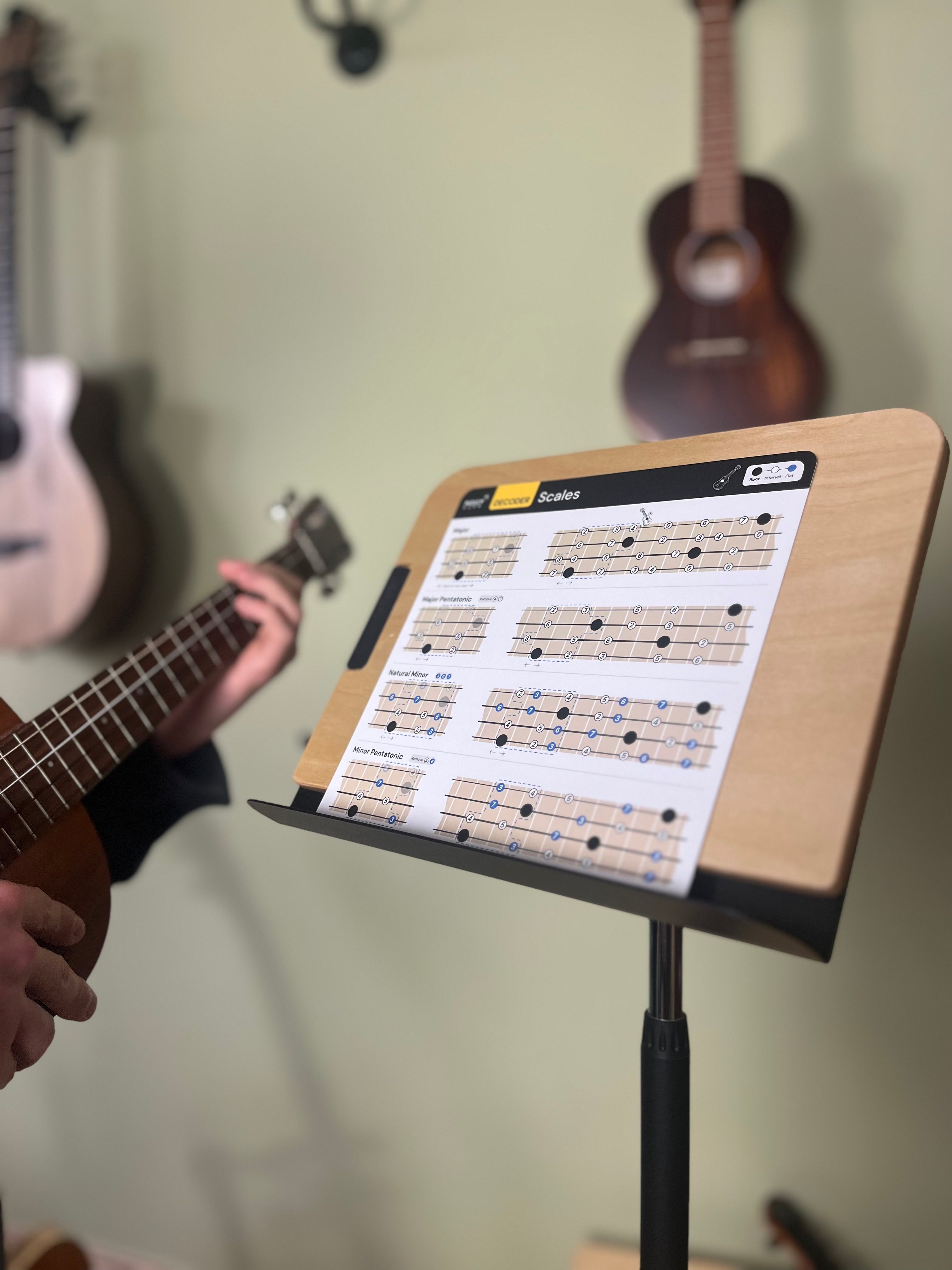Orientation:
The Noisy Clan Cheat Sheet for scales visually shows you the structure of 6 different scales. It is important to practise the scale across various positions on the fretboard to familiarise yourself with each distinctive sound and pattern.
A great place to start is with the major and minor scales. When you have a good feel for the major scale, extend your exploration to the minor scale, known for conveying a mood of melancholy and introspection. Both the major and minor scales play pivotal roles as foundational elements in numerous musical compositions, rendering them essential for any budding ukulele player.
The left side of the scales cheat sheet will highlight one of the scale positions to get you started. The transparent notes seen above capture the next octave.

The right side of the sheet shows you that the scale can be built from any of the roots you see. Just remember to follow the sequence of numbers!

Application:
Major Scale
The major scale is the starting point for understanding every other type of scale. As a ukulelist, scales are extremely useful because they form the foundation for solos and melodies, and even composing your own songs. The major scale follows the pattern of tones and semitones shown below. It does not matter which key we are in - the major scale will always follow this pattern.
The major scale contains 7 notes in an octave. The scale’s structure includes 5 whole tone intervals, and 2 semitone intervals per octave.
Major Scale Pattern: W >W> H> W> W> W> H
W = Whole Tone (two semitones)
H = Half Tone (one semitone)
Playing the major scale on a single string is great for learning the major scale pattern:

You can put together any major scale based on this combination of whole and half tones, starting with any note.
Major Pentatonic
The major pentatonic scale follows the same pattern as the major scale, but omits the 4th and 7th scale degrees, so only uses 5 notes per octave (hence ‘penta’). The pentatonic scale removes the more dissonant notes and harmonises well when played over most chords in the key.
You can use your Decoder, or Digital Decoder to find the notes in the major pentatonic scale.
Turn your Decoder to the key of G and work out the pentatonic scale. Ignore the 4 and 7 windows as they are omitted in this scale.
You should end up with:
G > A > B > D > E = 1 > 2 > 3 > 5 > 6
(Natural) Minor Scale
Just like the major scale, the minor scale’s structure includes 5 whole tone intervals, and 2 semitone intervals per octave. However, the pattern of tones and semitones is different to the major scale, resulting in a different sound.
Minor scale pattern : W > H > W > W > H > W > W
The minor scale flattens three notes, the 3rd, 6th and 7th.
Minor pentatonic
A minor pentatonic scale is a scale that has 5 notes per octave (same as the major pentatonic).
Give it a try yourself, using the minor pentatonic shape:

Blues (Major & Minor)
The minor blues scale can be conceptualised as a minor pentatonic scale with the inclusion of a flattened fifth note, commonly known as the blue note. This particular note defines the essence of the minor blues scale, conveying a distinct ‘bluesy’ quality to your jazz soloing!
In contrast, forming a major blues scale involves taking the major pentatonic scale and introducing a blue note, specifically the flattened third of the key. The incorporation of this extra note contributes to the major blues scale's bluesy character, setting it apart melodically from the major pentatonic scale.
Relative Minor
To make matters even more complicated, the natural minor scale can also be called the relative minor scale! For every major scale, there is a relative minor scale. This scale shares all the same notes as the major scale, but we start playing from the 6th scale degree instead of the root note. However, as we start on the sixth note, known as the Aeolian mode, this scale will often have a sad or melancholy feel to it.
For C major, the relative minor will be A (the 6th note in the C major scale is A).

The scale sheet shows how the major pentatonic shape and relative minor pentatonic scale shapes overlap. As we can see, these scales share all the same notes. To play the major pentatonic, start on the root (black circle) and stay within the outlined grey box. To play the minor pentatonic, start on the 6 and stay within the outlined blue box.








